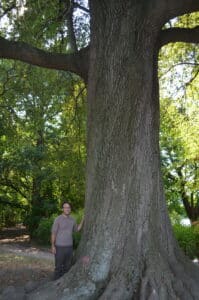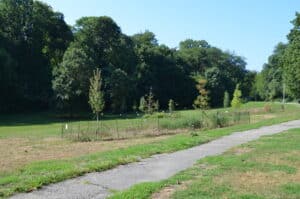7 Surprising Tree Facts
September 9, 2022
Prospect Park is home to 30,000 trees of over 175 species which provide a variety of essential benefits to our community of plants, people and wildlife. Here at Prospect Park Alliance, we’re asking you to Be a Park Champion by celebrating Tree Appreciation Month!
Prospect Park Alliance’s Landscape Management team plants and maintains trees strategically to help Brooklyn’s last remaining forest thrive and partners with NYC Parks Forestry staff to to sustain the health of the park and its trees. We chatted with the Alliance’s Forester, Mike Marino, for an inside look into 7 surprising facets of tree life in the park.
1. Slow and Steady Wins the Race
There is generally a correlation between how slow a tree grows and how long it lives. Trees that grow slowly are often the ones that live the longest and remain the strongest. If you spot an Oak tree over 40 inches or so in diameter, it’s likely to have been in the park for over a hundred years, and to have grown very slowly throughout its tenure in the park.
Fun fact: The London Plane trees by the Concert Grove Pavilion and the Lower Concert Grove were all planted at the time of the park’s creation about 150 years ago and are original to the design of the park. Oak and Beech trees are also two of the oldest native species found in Prospect Park, so keep an eye out for these strong and steady species throughout Brooklyn’s Backyard.

Marino alongside one of his favorite trees in the park: a centuries-old Willow Oak tree at the Peninsula off of Wellhouse Drive.
2. Trees Can Communicate
Through processes unseen by humans, trees can communicate and look out for one another. Trees release hormones through their leaves called volatile organic compounds, and nearby trees can sense and respond to these hormones. This can happen when one tree is infected with an invasive pest or other threat and through its leaves, sends a signal that something is wrong to another tree. The tree receiving this ‘warning’ can then protect itself by emitting a chemical in its bark that makes it less appetizing to a pest. This survival tactic means there is strength in numbers when it comes to trees– and environments like forests can help preserve species and protect trees.
3. Trees Could Not Exist Without Fungi
Visions of toadstools may be front-of-mind when you hear the word ‘fungi’, but small strands of fungi known as mycelium are essential to the health of all trees. These fungi strands perform a variety of important functions, including the decomposition of organic material to recycle nutrients back into the soil. With the help of mycelium, the tree’s roots are able to extend their reach and retrieve the nutrients and water they need to thrive. Through their roots and through fungi, trees can also send nutrients and minerals to other trees, sometimes even trees of different species, to help their fellow trees stay healthy.

A grove of young trees planted as part of Prospect Park Alliance’s Commemorative Tree Program.
4. The Older the Tree, the Greater the Benefits
From cleaning our air, removing toxins, providing wildlife habitats and more, we receive immense environmental benefits from trees. But the benefits of ten young trees do not measure up to the benefits provided by one 100 year old tree. We need mature trees to reap the full span of benefits to our health and environment. Mature trees give shade and cool down the air, they are able to absorb more water which mitigates flooding, and capture greater quantities of carbon dioxide and produce more essential oxygen for us to breathe.
These benefits of fully-grown trees make it all the more essential to be good stewards to both the long-standing trees of Prospect Park and the newly planted ones that will continue to grow, mature and benefit our community for centuries to come.
5. Trees Mist Us
Ever wonder how exactly parks stay so much cooler than city streets in sweltering summer heat? Trees are to thank for the wave of relief we feel from parks in the summer months. Through a process called evapotranspiration, mist gets spritzed out through tree leaves and into the air, keeping the air relatively cool compared to city streets.
Thanks to these trees, on hot summer days, the temperature inside the park can be as much as 10 degrees cooler than the surrounding concrete streets. A single tree can have the same effect as 5 medium air conditioners—with zero electricity used. In Prospect Park, a recent survey of 12,000 of the park’s trees found that our forest produced the equivalent of over $853,874 every year!
6. Forward-Thought is Key
Alliance Landscape Management staff work in collaboration with NYC Parks Forestry staff year round to prune, maintain and care for the park’s landscape and woodland areas to make sure trees in all stages of life are as healthy as possible to benefit our community for generations to come. By considering the way people use the park, the ecology, safety, and health of individual trees, the Alliance and NYC Parks Forestry teams use a multidimensional approach to keep the woodlands and landscape of the park healthy and thriving.
Prospect Park Alliance’s Landscape Management staff work to plant varying tree species that grow well together throughout the park to help strengthen the health and resilience of Brooklyn’s Backyard. If there’s one invasive pest or environmental stressor that attacks a certain type of tree, a diverse range of species makes it so that an entire forest isn’t wiped out in response to something unexpected in the environment. This is a way of having contingencies and back-ups to keep our forest and landscapes healthy.
“Even when we plant new trees, we’re looking 50 years down the road,” says Marino. “This tree will get bigger: How will it play with its neighboring trees and the uses of the park? What pruning will be needed to provide a strong foundation? We need to have forward-thought as we provide proactive work and care.” Marino emphasizes that this is also where stewardship comes in, “All of our daily interactions with the trees, no matter how small, accumulate and impact trees at all stages. Stress builds up in trees, just as it does in humans. And physically, if we damage a tree’s bark, it’s as if our organs were directly beneath our skin, with nothing to protect us from our environment.”
7. Every One Of Us Can Help Prospect Park’s Trees
To help our community reap the benefits of century-old trees and help young trees continue to thrive for future generations, remember to admire trees from afar and not to pick any leaves, flowers or bark that our ecosystem of people, plants, and animals need to stay healthy. Remember not to hang decorations or hammocks on trees to help keep the trees of Brooklyn’s Backyard green and thriving.
Marino also recommends getting involved and learning as much as possible about trees to help support our ecosystem. Resources to learn about the trees of Prospect Park and beyond range from participating in volunteer opportunities, visiting the TreeKeeper Database to explore the specific environmental benefits of each tree in Prospect Park, reading up on tree behavior in books (Marino recommends Peter Wohllleben’s The Hidden Life of Trees), or even taking classes and becoming a licensed street tree pruner with the Trees New York Citizen Pruner Course.